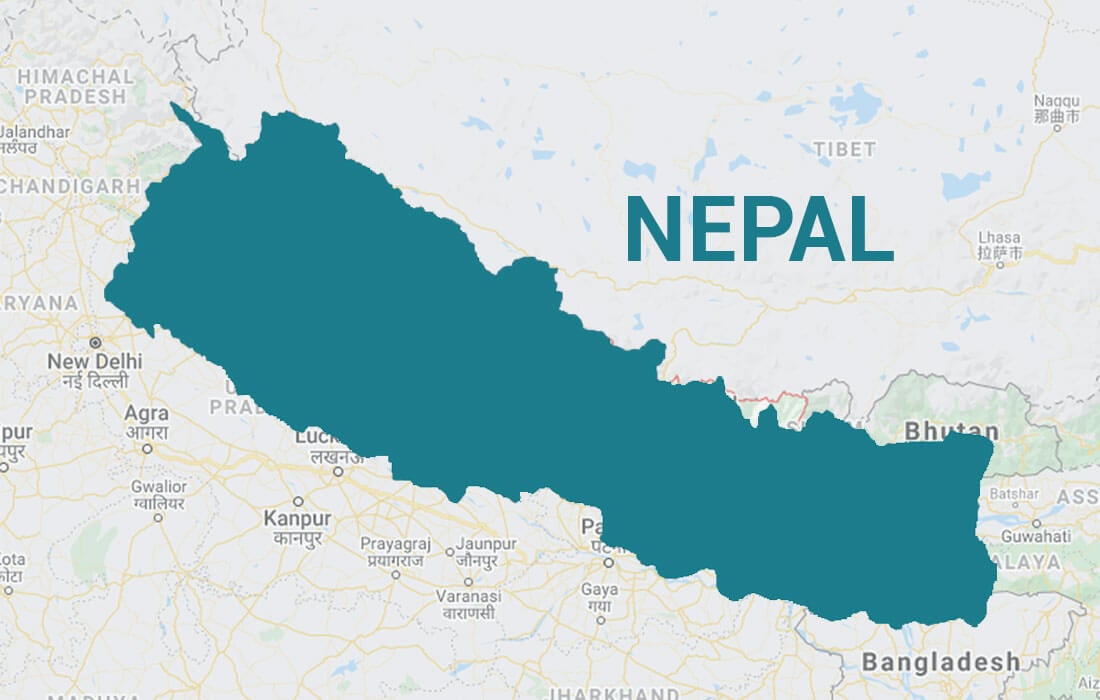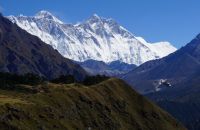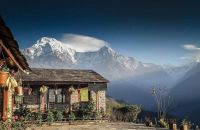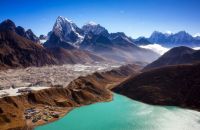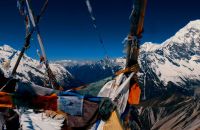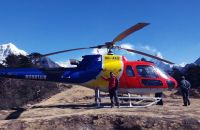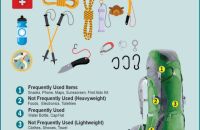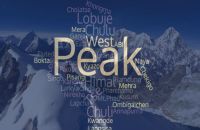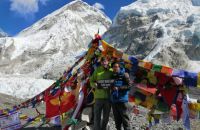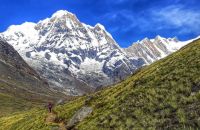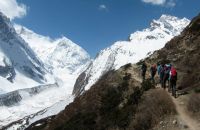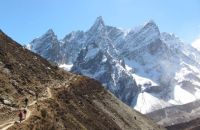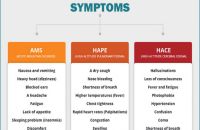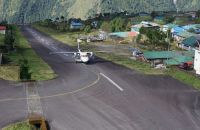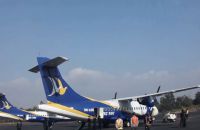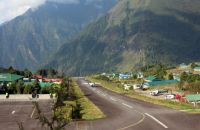Talk with our local travel specialist who can help organize your trip.
Best time to Visit Nepal
Nepal is one of the most popular travel destinations in the world, known for its majestic mountains, diverse landscapes, incredible culture, and welcoming people. The country is home to some of the highest mountains in the world and several natural and cultural wonders. One of the most popular attractions in Nepal is Mount Everest, the highest peak in the world, and besides are several other mountain ranges. Nepal has a vibrant food scene and is also considered Disneyland for adventure. Not to mention, Nepal has a vibrant food scene, with a variety of dishes that are unique to the country. Every year hundreds of thousands of travelers visit Nepal for unforgettable travel experiences.
One must choose the best time to visit Nepal for a memorable and enjoyable trip. This is because the weather and climate of Nepal vary significantly throughout the year and you should therefore consider the time of your visit. In this blog, we shall discuss the best time of the year to visit Nepal and many more related topics.
Seasons In Nepal
You will be interested to know that the Nepalese divide the year into six seasons or Ritu (season in Nepali) - Basanta (Spring), Grishma (Summer), Barkha (Monsoon season), Sharad (Early Autumn), Hemanta (Late Autumn) and Shishir (Winter).
While locally the year is divided into six seasons, the tourism sector follows the traditional seasonal division, ie, Spring, Summer, Autumn and Winter. Here’s what you can expect in each season.
Spring (March To May)
Spring in Nepal is one of the best seasons to visit Nepal. The weather remains pleasant and warm, neither too hot nor too cold. Flowers bloom and the trekking trails are covered with rhododendron flowers and wild orchids. To celebrate the onset of this wonderful season colorful and vibrant festivals like Holi, Mahashivaratri, Bisket Jatra, etc. are celebrated.
Where to go and what to do in Spring?
Spring is the ideal season for Trekking and Hiking holidays. You can head to the mountains and walk beneath the high peaks. Take the popular Everest Base Camp Trek, Annapurna Base Camp trek, Ghorepani Poon Hill trek or traverse through the high mountain passes of Thorung La (Annapurna Circuit), Chola, and Renjo La. If you prefer solitude, then you can walk through the less crowded trails of Langtang Valley or Manaslu Circuit.
The hills around Kathmandu and Pokhara are ideal for day hikes and family excursions. Physically less strenuous and demanding than high-altitude treks, short day hikes take you across a rural landscape filled with terraced fields and small traditional villages.
If we have to talk about the drawback of traveling in summer, the only disadvantage of the spring season is the overcrowded trails. Adding to this, accommodation can be expensive during the peak season.
Spring is the ideal time for helicopter tours. You can head to Everest or Langtang and enjoy aerial views of some of the highest peaks in the world. Everest Heli Treks offer you the luxury of trekking to EBC and returning to Lukla via helicopter. If you are an active person you can also try some multi-activity sports like paragliding, bungy jumping, mountain biking, etc.
Summer (June To August)
The balmy days of spring soon give way to hot and humid summer. The temperatures rise and days become humid in summer in Nepal. In the Terai, region temperatures soar above 37 degrees Celsius during summer.
The summer season is also characterized by monsoon rains. While the early summer months are hot and humid with sudden bursts of thundershowers, mid-summer is generally wet with the Monsoon in full swing. There’s continuous rainfall till early September. June, July, and August are the wettest seasons.
During this summer season, there is abundant greenery and though not an ideal season to trek, the verdant hillsides are worth exploring during this time of the year. Homage to the Rain God (Rato Machindranath Jatra) is offered during this time.
The birth anniversary of the world’s greatest teacher Lord Buddha is also held during this time. Fertility festivals like Ubhauli and Teej are observed. The Brahmins change their sacred thread (Janai Purnima) in this season.
While most of Nepal enjoys the wet spell brought by the monsoon season, the region lying close to the Tibetan plateau remains relatively dry. The regions of Mustang, Dolpo, and parts of Manaslu lie below the rain shadow and thus receive no rainfall during the summer months. During summer, there is a high chance that the country experiences heavy rainfall and high humidity. Other than that, insects and mosquito bites and limited tourist services are the drawbacks of traveling in summer.
Where to go and what to do in Summer?
People don’t usually travel to Nepal during this time. Summer is the official ‘off-season’ in the tourism circle. But there’s an advantage to plan your travel during this time. The upside of traveling during the off-season is, you get to avoid the crowd and enjoy awesome off-season deals and discounts. Most of the service providers offer off-season discounts.
Moreover, the landscape is worth a view at this time of the year. The green paddy fields, verdant hills covered with mist and lush rivers, a summer trip to Nepal will reward you with glorious views. Take a village tour and explore the medieval villages of Khokana and Bungamati in Kathmandu Valley.
If you intend to trek to the mountains, you can head to Mustang, Dolpo, or the Tsum Valley. These places lie under the rain shadow and thus receive no rainfall. If you are a hardcore kayaker or rafting enthusiast you can ride on the rapids of the Himalayan rivers.
Autumn (September To November)
Autumn season is the most popular season for tourists visiting Nepal. The skies remain clear. The days are warm and pleasant, but the nights can turn a bit chilly. The humidity disappears and the temperatures remain moderate. The trekking trails are crowded with trekkers as this season offers the best views of the Himalayan peaks.
Autumn is one of the peak seasons because the two biggest of the Nepalese, Dashain and Tihar, are celebrated around this time of the year. In Kathmandu, the annual Indra Jatra is held where the chariot of the Living Goddess Kumari is pulled across the streets of the old city.
Where to go and what to do in Autumn?
Autumn, like Spring, is another favorite season for travelers visiting Nepal. This season sees the return of the trekkers and mountain climbers. Popular trails like Everest and Annapurna are filled with trekkers from all over the globe. The mountain views are absolutely amazing during this time as the weather remains clear and stable.
Hiking around the mid-hills during this time will allow you to be a part of Dashain and Tihar festivities, the major festivals celebrated by the Nepalese. Nepalese are generally warm and friendly and they love inviting guests to their home, however humble it may be. Traveling in the Terai lowlands is also ideal during this time. You can visit Lumbini, the birthplace of Lord Buddha, Chepang villages, Chitwan National Park, Bardiya National Park, etc.
As the weather remains stable, outdoor activities like paragliding, white-water rafting, bungy jumping, mountain biking, etc. can be done during this time.
The best time to do Everest Base Camp trek and Annapurna Base Camp trek is either spring (March, April, May) or Autumn (Sept, Oct, and Nov). During the spring season, the trails will be covered with blooming flowers and the weather is excellent with clear blue skies.
During Autumn, the monsoon clear away and the snow melts, leaving behind naked mountains with very less snow on them. Autumn is ideal for trekking and it is also one of the best seasons to visit Nepal for merrymaking and travel. Just like in spring, the crowd is the major drawback of traveling during the autumn season in Nepal. As autumn is the peak tourist season, prices for accommodations and other services can be higher than during other times of the year.
There are other short treks like the Ghorepani-Poon hill trek that can be arranged throughout the year. Helicopter tours to Everest Base Camp can be done throughout the year.
Winter (December To February)
In the mountainous and hilly regions, winters are harsh. Temperatures dip below 0 degrees in the high mountains. Snowfall and many locals living in high altitudes migrate to the lower regions to escape the freezing cold. In the mid-hills like Kathmandu and Pokhara, the temperatures plummet almost to 4 degrees celsius.
Winter is the best season to visit Nepal to explore the Terai lowlands, as the weather remains generally pleasant during this time. Jungle Safaris to the national parks of Chitwan, Bardia, and Koshi Tappu can be scheduled around this time.
Festivals celebrated during this season are Chhath (dedicated to the Sun God), Yomari Punhi (harvest festival), and Losar (Buddhist New Year).
Where to go and what to do in Winter?
Winter is ideal for wildlife safaris and city tours. Though city tours can be done any time of the year, you can explore the cultural sites in peace during off-seasons like winter without hordes of tourists jostling around you.
Winter is the perfect time for the cultural and city tours. You can explore the medieval durbar squares in Kathmandu - Basantapur, Patan, and Bhaktapur. You can also travel to ancient Newari towns of Panauti, Bandipur, and Sanga. You can combine multi-city tours in your holiday itinerary and visit Kathmandu, Pokhara, Chitwan, and Lumbini.
However, on the flip side, winter is considered an off-season for trekking and mountaineering in Nepal. The cold weather, limited accessibility of services like accommodations, restaurants, and transportation options and the risk of avalanches in the mountain areas are the major drawbacks.
You can also head to the lowlands of Chitwan, Bardiya, and Koshi Tappu for a wildlife experience. During winter, birds from the Tibetan highlands and the Himalayan mountains migrate down to warmer areas like Chitwan and Koshi Tappu.
Winter is the right time for bird-watching tours. You can also discover the geographical diversity of Nepal by taking a road trip to the Terai lowlands. Explore Nepal’s western regions - Karnali, Mugu, Khaptad, and border towns.
Nepal may be a tiny country, but its diversity in terms of landscape and culture will take your breath away. The country is not only about mountains. Its lowlands and valleys are also equally rich in natural beauty and culture. There’s so much to explore and discover in Nepal that a season may not be enough for you!
So, if you're planning a trip to Nepal, make sure to consider the best time to visit based on your interests and preferences. Keep in mind the different seasons and their unique offerings, as well as any special events or festivals you'd like to experience.
Popular Festivals and Events
Nepal is a diverse country full of vibrant festivals and events throughout the year, which are an integral part of the Nepali lifestyle and are celebrated with great enthusiasm. Dashain, Tihar, Holi, Buddha Jayanti and Teej are some of the most popular and widely celebrated festivals in Nepal. Additionally, Indra Jatra, Nepali New Year, and Shiva Ratri are among the many festivals in Nepal. During the festivals, people come together to celebrate with a great deal of zeal and significance. In a way, festivals and events in Nepal are a way of life here. These festivals are often tied to the changing seasons and have unique cultural significance.
Spring season is marked by amazing festivals like Holi, Nepali New Year, and Bisket Jatra. During the autumn season, many festivals like Dashain, Tihar, and Chhatt are celebrated. Therefore, autumn season is the perfect time to visit Nepal if you wish to immerse in Nepal's significant festival, Dashain. Rato Machhindranath Jatra, Janai Purnima, Nag Panchami, and Guru Purnima are among the top festivals during summer. The winter season in Nepal falls between December to February. During this season, several festivals and events like Maghe Sankranti, Lhosar, Christmas, and New Year are celebrated.
Trekking in Nepal
Trekking in Nepal is one of the most popular adventure activities. With its stunning Himalayan Mountain ranges, diverse landscapes, and rich cultural heritage, Nepal calls trekkers from around the world. Everest Base Camp Trek, which takes the trekkers to the base camp of the highest mountains in the world, is the most popular trekking destination in Nepal. Trekking in Nepal can range from easy and moderate to challenging and strenuous. Trekkers can choose from a range of treks that suit their fitness level, time constraints, and budget. Rest assured; there's a trek for everyone.
Generally, the two main trekking seasons in Nepal are the autumn season (September to November) and the spring season (March to May). However, there are certain regions and altitudes that are best trekked during specific seasons.
The best time to trek in the Everest region is during the autumn and spring seasons. The winter season (December to February) and the monsoon season (June to August) are not recommended for any trek in this region. The high probability of snowfall and rain makes it hard for trekkers to traverse and make it up to the base camp or the viewpoints.
Similarly, it is the same with Annapurna, Langtang, Upper Mustang, Manaslu and other regions when it comes to the best time of the year for trekking. The winter season can be extremely cold in any trekking region. Monsoon is a BIG-NO for trekking in the Annapurna region as well. One thing to keep in mind is that it can be extremely challenging to trek during monsoon season. It is also important to note that weather patterns in Nepal can be unpredictable, and it is always best to check weather conditions and forecasts before embarking on a trek.
Wildlife and Nature
Nepal boasts 11 national parks, 6 conservation areas, and 3 wildlife reserves, which are home to a wide variety of flora and fauna. Similarly, the Himalayas are home to several glaciers, lakes, and rivers. Nepal also has lush green valleys, rolling hills, and lowlands, which provide habitats for various wildlife. One-horned rhinoceros, Bengal tiger, snow leopard, and red panda are some of the rare and endangered wildlife species in Nepal. The national parks and conservation areas offer huge opportunities for visitors to observe and appreciate Nepal's wildlife and natural beauty.
The best time to spot natural wildlife and observe natural phenomena depends on the specific activity, but in general, October to April is considered the best time to spot wildlife in Nepal. During this time of the year, also called Dry Season, mild temperatures and clear skies make it the perfect time to spot animals as they come out to bask in the sun or search for water. One of the most incredible natural phenomena one can observe in Nepal is the blooming of rhododendron flowers. For this, visitors must travel from March to April. The hills and lush forests of Nepal are adorned with vibrant pink, red, and white flowers. September to November and from March to May is a great time to spot migratory birds.
Packing and Preparing for Your Trip
If you are planning to visit Nepal, make sure to pack and prepare according to the season and destination. In summer, it's all about lightweight clothing and accessories that keep you cool and comfortable. So, pack lightweight and carry basic clothes and stuff. In winter, make sure to pack an extra layer of clothes to fight cold weather. Pack a heavy coat, a warm hat, gloves, scarves, warm socks, and waterproof boots. Similarly, for spring weather, it's best to pack a mix of warm and cool weather clothing.
Now, let's talk a bit about health and safety considerations for each season. Starting with spring, there are risks of allergies and respiratory infections due to changing weather. You are suggested to wash your hands frequently and carry essential medications. In summer, the heat and sun can pose a health risk. You have to wear sunscreen and stay hydrated. Additionally, the risk of heat exhaustion or heatstroke is another risk of traveling during summer.
In winter, it is the cold temperature that is the main problem. Wear warm clothing and layer appropriately, cover your nose and mouth when outdoors to protect against cold air, and avoid prolonged exposure to the cold. And for monsoon season, it is best suggested to avoid traveling. However, if you travel, make sure to carry raincoats and mosquito repellent, wear long-sleeved clothing and pants, and sleep under a mosquito net if possible.
For general tips on packing and preparing, we suggest you pack appropriately for the season you'll be traveling in. Staying hydrated is the key factor for a successful adventure. Also, respect local culture and don't forget to carry cash. Now that the new rule is implemented make sure to organize your trip from a reputed travel agency. And finally, while Nepalese cuisine is delicious, it's important to be cautious of street food to avoid foodborne illnesses.
Conclusion
Although you can travel to Nepal all year round, the best time to visit depends on your preferences and interests. In general, spring and autumn are the best time of the year for the best travel experience. If you want to experience Nepali culture and festivals, the best time to visit is during the festival season. If you're planning on trekking in Nepal, the best time to visit depends on the region you're trekking in. For example, the Everest Base Camp trek and Annapurna Circuit trek are best done during the spring and autumn when the weather is mild and the skies are clear.
However, the Upper Mustang trek is best done during the summer when the monsoon season is over.
Responsible and sustainable tourism is particularly important in Nepal, given the country's fragile ecosystem and rich cultural heritage. Environmental conservation, cultural preservation, and community empowerment are some key reasons why responsible and sustainable tourism is important in Nepal. Everyone must be responsible while traveling in Nepal to help to ensure that Nepal's unique natural and cultural heritage is protected for future generations. You must support local businesses and respect the environment in Nepal for sustainable tourism in Nepal.
When planning your trip, choose tourism operators who are committed to responsible and sustainable tourism practices. When in Nepal, support local businesses by shopping at local markets, eating at local restaurants, and staying in locally-owned accommodations. Of all, the most important thing to do is to use a reusable water bottle and say no to single-use plastic.
- Written by: Naba Raj Amgai
- Updated: Tuesday Apr 11, 2023

